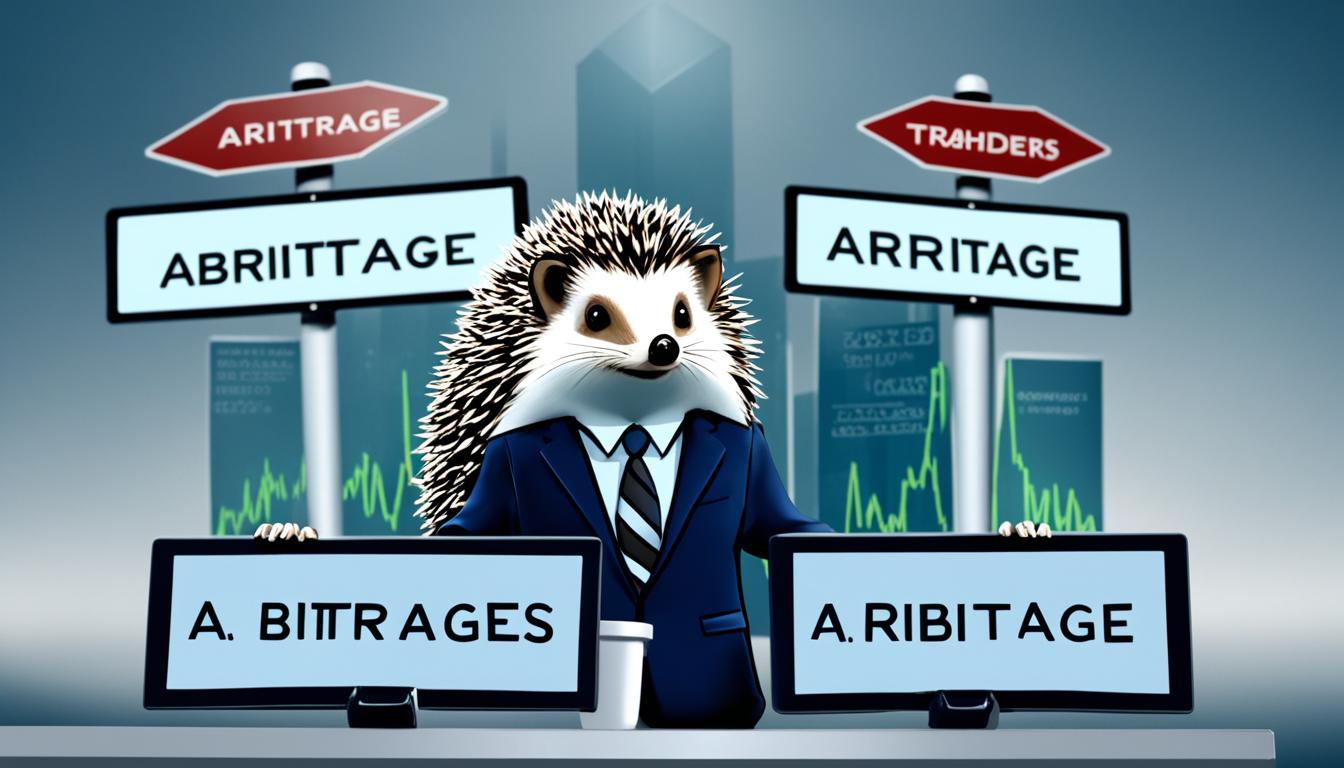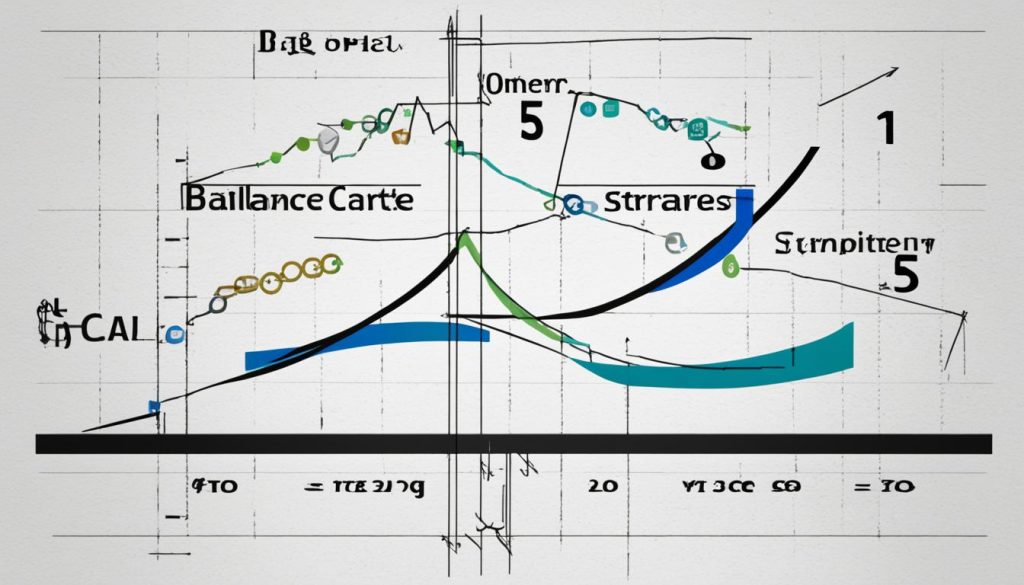Hedge arbitrage trading is a smart way traders use to make money from market flaws. They look for price differences in related financial instruments to profit. At the same time, they manage risks. This method helps traders reduce risk and increase profits in their portfolios.
Risk arbitrage is one key approach. It finds profit chances from mergers and acquisitions. Merger arbitrage, on the other hand, focuses on price differences in companies joining forces. The main aim is to use these gaps to make solid returns. This keeps risks under control for investors.
Key Takeaways
- Hedge arbitrage trading leverages market inefficiencies to generate profits.
- Techniques such as risk arbitrage and merger arbitrage are fundamental strategies used by hedge funds.
- Investment portfolios incorporating hedge arbitrage aim to minimize risk while maximizing returns.
- Understanding market conditions and pricing models is essential to effective arbitrage trading.
- In-depth financial analysis and insights from experts significantly enhance trading outcomes.
Introduction to Hedge Arbitrage Trading
Hedge arbitrage trading is a key element in today’s finance world. This section explains how hedge funds use strategies to find and use arbitrage chances. It shows how these trades are important in the financial markets. Traders use stocks, bonds, derivatives, and currencies to find and use market inefficiencies. They aim for consistent returns.
The core of hedge arbitrage trading is arbitrage, or buying and selling similar assets in different markets for profit. Hedge funds use complex models and algorithms to spot these chances. They pick financial instruments that match their strategies well.
The success of these strategies depends on the financial instruments chosen. Stocks, bonds, and derivatives each have their roles in arbitrage. The liquidity and volatility of currencies also offer special opportunities. Hedge funds focus on these aspects to make profits from small price differences.
Looking closely at financial literature shows why it’s important to understand pricing models for arbitrage. Real stories from experienced traders give insight into these strategies. Plus, analyses of market data show they work. These sources help explain how hedge funds navigate arbitrage trading’s complex world.
| Financial Instrument | Common Arbitrage Uses | Market Inefficiencies Targeted |
|---|---|---|
| Stocks | Pairs Trading, Merger Arbitrage | Price Disparities, Acquisition Announcements |
| Bonds | Convertible Arbitrage, Yield Curve Arbitrage | Interest Rate Differentials, Credit Spreads |
| Derivatives | Options Arbitrage, Futures Arbitrage | Volatility Mispricing, Cost of Carry |
| Currencies | Currency Arbitrage, Interest Rate Parity | Exchange Rate Fluctuations, Economic Announcements |
Key Hedge Fund Strategies in Arbitrage
Hedge funds use different strategies to make money from market inefficiencies. We will look at three main strategies used in hedge arbitrage trading. We’ll explain how they work and their advantages.
Market Neutral Trading
Market neutral trading tries to avoid market ups and downs. It does this by holding both long and short positions in related assets. The goal is to offset market risk and focus on the relative performance of these assets. This technique aims for steady returns no matter which way the market goes, making it safer for investors.
Statistical Arbitrage
Statistical arbitrage uses advanced algorithms and models to spot price differences in related financial products. It’s based on the idea that prices will eventually return to the average, correcting any oddities. Traders adjust their positions based on statistical cues. This helps them take advantage of short-term price changes, increasing both risk management and profits.
Pair Trading
Pair trading puts together a long position and a short position in two closely linked stocks. Say Company A and Company B usually move together but suddenly do not, traders will buy the lagging stock and sell the leading one. They bet that the price difference between the two will disappear, creating a chance for risk-free profit.
| Strategy | Key Feature | Benefit |
|---|---|---|
| Market Neutral Trading | Simultaneous long and short positions | Minimizes market risk |
| Statistical Arbitrage | Use of quantitative models | Exploits price discrepancies |
| Pair Trading | Matched long and short positions | Low-risk arbitrage |
Quantitative Trading: The Backbone of Arbitrage
Quantitative trading is key for many arbitrage tactics. It uses math and stats to make better trading decisions. Algorithm development is important here, helping to spot and make trades fast. With financial modeling, traders can guess market changes and polish their strategies for more gains. They play a big part as risk arbiters, finding and lowering trading risks.
Developing algorithms is vital in quantitative trading. It lets traders automate tasks and quickly react to market shifts. These algorithms sift through tons of data to spot chances for profit that humans might miss. This tech keeps quantitative trading as a top method for finance companies.
Financial modeling also helps a lot. It makes decision-making smoother with predictive analytics. By creating precise models, traders predict market trends better. They rely on data, not just guesses, for their decisions. This method makes quantitative trading even more effective in the fast-moving financial world.
In hedge funds, quantitative traders act as risk arbiters. They ensure strategies fit the firm’s risk level. They keep an eye on risk and tweak portfolios to balance risk and reward well. This role is crucial for the success and growth of arbitrage in a competitive finance scene.
Quantitative trading combines finance and tech, opening a new phase for arbitrage. It shows that smart algorithms and solid financial models are essential. They help navigate the complex world of today’s markets.
Algorithmic Trading and Its Role in Hedge Arbitrage Trading
Algorithmic trading has changed the way hedge arbitrage trading works. It uses speedy, automated methods to spot and make trades fast. These algorithms are powered by top-notch trading programs. They handle many transactions in milliseconds.
High-frequency trading is a part of algorithmic trading. It uses advanced tech to handle loads of trading orders super quickly. This is especially useful in hedge arbitrage trading. Why? Because even milliseconds can make or lose money. High-frequency trading grabs arbitrage chances swiftly, reducing missed opportunities.
Programming is key to these automated strategies. Traders use Python, C++, and Java for crafting complex algorithms. These can sift through huge amounts of data to find arbitrage openings. They are designed to be flexible, adapting to different market conditions with various trading approaches.
| Aspect | Description |
|---|---|
| Algorithmic Trading | Utilizes automated systems to execute trades based on predefined criteria. |
| High-Frequency Trading | Specializes in executing a large number of orders at rapid speeds, important for capturing fleeting arbitrage opportunities. |
| Programming in Trading | Involves creating complex algorithms using languages like Python and C++ to analyze data and execute trades effectively. |
| Automated Strategies | Set trading rules based on statistical models, ensuring trades are executed automatically without manual intervention. |
Algorithmic trading greatly affects market dynamics. It makes transactions faster and more precise in hedge arbitrage trading. Algorithms use predictive analytics and financial modeling to foresee market trends accurately. This optimizes arbitrage strategies. Also, rules on algorithmic trading keep the market fair and transparent. They help reduce the risks that come with high-frequency trading.
In conclusion, algorithmic and high-frequency trading have transformed hedge arbitrage trading. The combination of advanced trading programming and new technology allows traders to take advantage of arbitrage opportunities. This brings an unmatched level of speed and accuracy to the financial markets.
Conclusion
Hedge arbitrage trading is complex and needs careful strategy application to succeed. It involves advanced methods like market neutral and statistical arbitrage. Along with pair trading, these strategies need detailed planning and a deep financial understanding.
Risk management and following rules are also key. This requires a high level of financial skill and knowledge of each strategy’s details.
Technology has transformed arbitrage trading significantly. Using algorithms and financial models makes trading faster and more efficient. These tools help traders make smart decisions based on data.
As trading platforms advance, traders can now quickly take advantage of market gaps. This highlights the importance of being tech-savvy in today’s trading strategies.
To stay ahead in hedge arbitrage trading, keeping up with market trends is essential. The market is always changing, so traders must be vigilant and adaptable. Understanding strategies and using technology effectively is vital for success.
This blend of strategic insight and tech know-how is key to excelling in this competitive field. Thus, traders who combine these strengths are most likely to succeed.
FAQ
What is hedge arbitrage trading?
Hedge arbitrage trading is a way to make a profit by finding price differences in related financial products. Traders look for these gaps to lower risk and increase profits. They use different methods to do this.
What are the key components of market neutral trading?
In market neutral trading, a portfolio is created to avoid the impact of market swings. It does this by buying and selling securities that are connected. The aim is to earn profits regardless of market direction.
How does statistical arbitrage work?
This approach uses math to spot price gaps in securities. Traders use this to make profits. It’s based on mean reversion, which means prices will go back to their average over time.
What is pair trading in hedge arbitrage?
Pair trading means buying one stock and selling another within the same industry. They should be closely linked. The goal is to earn from the different performances of the two stocks.
How does quantitative trading underpin arbitrage strategies?
Quantitative trading uses math and stats for trading decisions. Algorithms find and use arbitrage chances. This helps in managing risk.
What role does algorithmic trading play in hedge arbitrage?
Algorithmic trading changes hedge arbitrage by enabling fast, automated trade. This lets traders quickly take advantage of arbitrage opportunities.
Which financial instruments are commonly used in hedge arbitrage trading?
Hedge arbitrage often involves stocks, bonds, derivatives, and currencies. These are chosen for their price models and market inefficiencies.
What is merger arbitrage?
Merger arbitrage is about making profits from price differences in companies undergoing mergers or acquisitions. Traders bet on the deal’s success to earn money.
How can financial modeling aid in quantitative trading?
Financial modeling predicts future prices and market trends. It uses past data and statistics. This makes trading algorithms more precise and effective.






